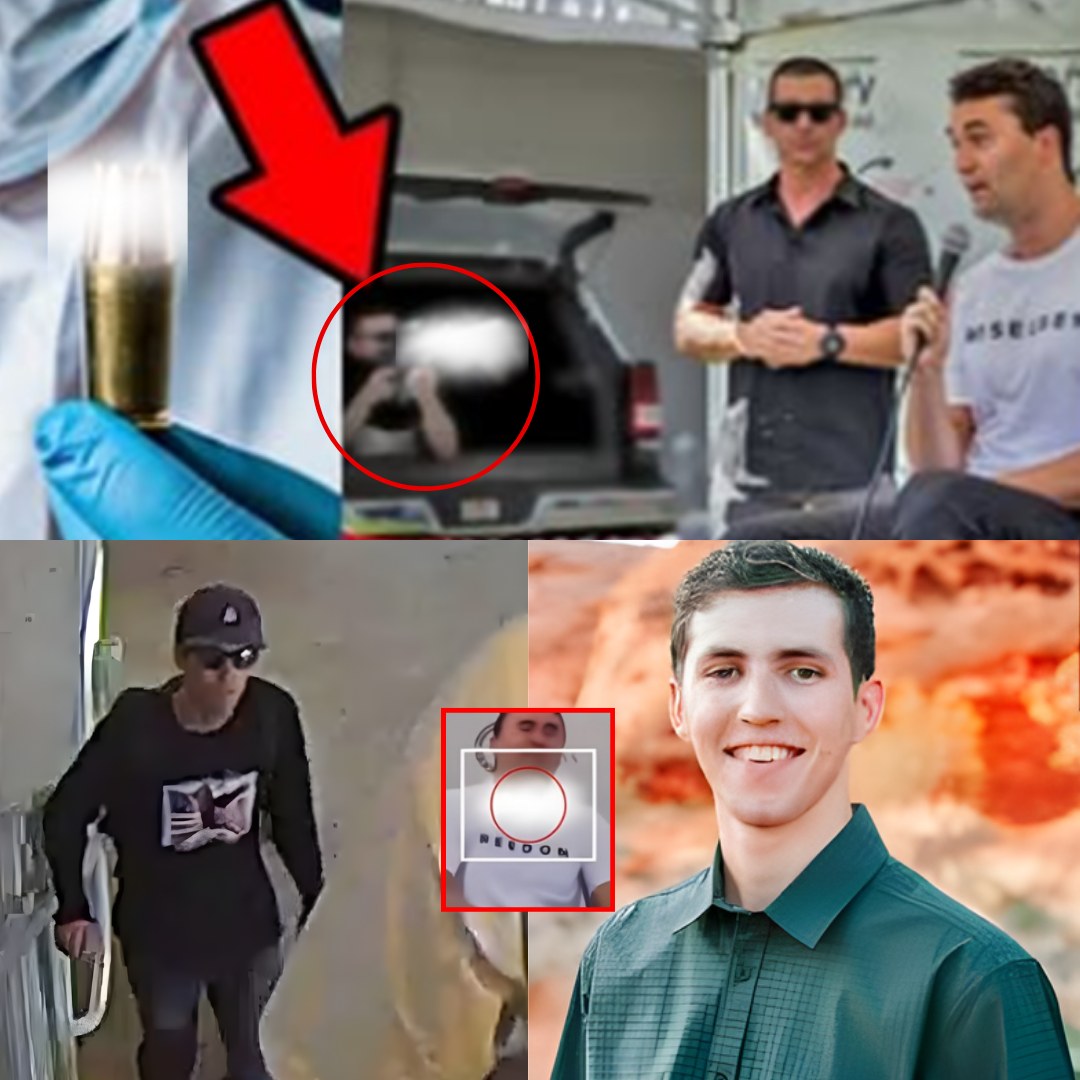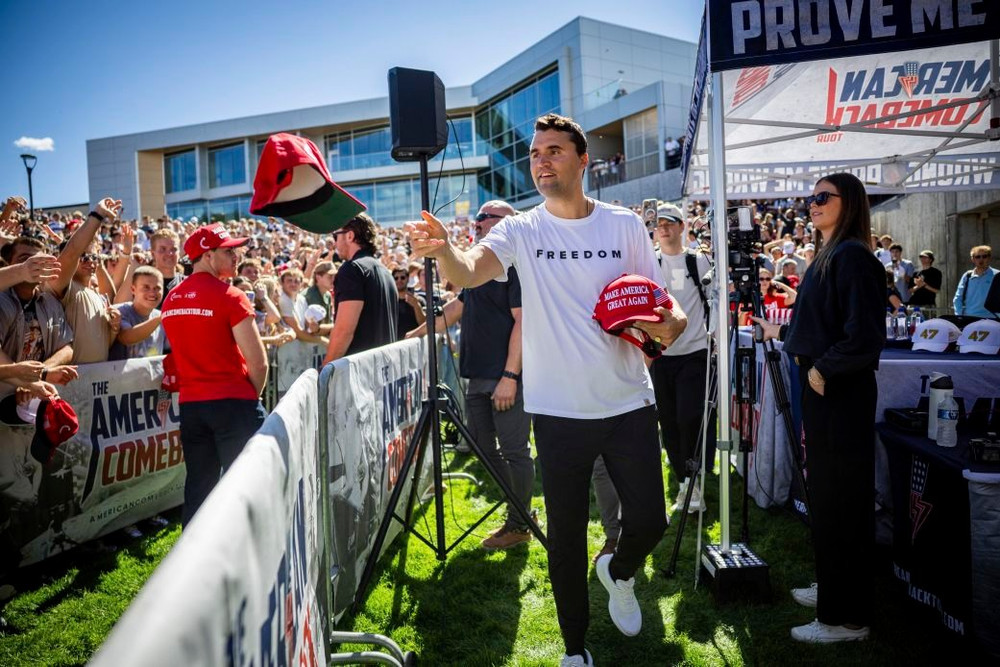
The clip they didn’t want you to see — pause at the 6-second mark”: Security footage reveals what really happened just moments before the incident — The frame removed from the public broadcast changes everything.
The Clip No One Was Supposed to See
It began as an ordinary day — until the clip surfaced.
The footage appeared online quietly, uploaded to a small, obscure channel late at night. It wasn’t labeled with anything special, just a time stamp and a location. But within hours, it had spread across social media like wildfire.
The reason?
At the six-second mark, something changed.
Viewers noticed it first — a subtle flicker, a shift in the lighting, and then… a movement. Something — or someone — appeared in the background, just behind where Charlie Kirk had been standing moments before the chaos began.
And then, just as quickly, the frame cut to black.
What made this even stranger was that the officially released version of the footage — the one aired on multiple networks and referenced in reports — didn’t contain that moment at all. It skipped directly to the aftermath.
That single, missing fraction of a second became the center of an internet storm.

The 6-Second Mystery
Independent analysts began dissecting every frame.
Forums buzzed with screenshots, comparisons, and slowed-down clips. One video technician claimed the shadow that appeared behind Kirk wasn’t random at all — it aligned perfectly with a tall figure entering from the left-hand side of the frame.
“Freeze it right before the cut,” one commenter wrote. “You’ll see it — the shape, the motion, even the reflection on the glass behind him. It’s there.”
Soon, hashtags began trending:
#The6SecondClip and #HiddenFrame.
Major media outlets ignored it at first, dismissing it as “conspiracy chatter.” But the noise only grew louder. Even reputable journalists started to ask questions:
Why was that exact frame missing from the official footage?
Who had access to the original files — and who decided what to show?
By the time the first expert statements emerged, millions had already watched the video. But no one could agree on what they were really seeing.

The Official Silence
When local authorities were asked about the discrepancy, their response was carefully worded:
“Due to privacy and ongoing internal reviews, certain frames were redacted for sensitivity reasons.”
But that answer didn’t calm anyone down.
If anything, it fueled more speculation.
Why would a frame showing nothing violent or explicit be classified as “sensitive”? What could possibly be in that brief moment that warranted removal?
Meanwhile, several technicians claimed to have seen the unedited footage before it was archived. One anonymous insider described it as “uncomfortable” but “not dangerous.”
“It’s not what people think,” the insider said. “But it raises new questions about what was happening around him before it all went wrong.”
They didn’t elaborate — and shortly after, the original account that leaked the statement disappeared.

The Unseen Frame
Days later, a low-resolution version of the supposed “missing frame” began circulating again — this time, enhanced by amateur investigators.
What it showed was subtle but undeniably strange.
In the background, a figure wearing what looked like a dark jacket could be seen leaning slightly forward, as if reaching for something. The lighting reflected off a surface nearby — possibly a phone or a metallic object. Then came the flicker. The image distorted for less than half a second, then jumped to the aftermath that had been widely broadcast.
To most people, it looked like nothing more than a compression glitch. But to those who had studied the video for days, it meant something else entirely.
“There’s intent in that movement,” one digital analyst said. “You can tell it’s not random noise. The system’s metadata shows an unnatural break — the kind that only happens when footage is intentionally edited.”
Still, no one knew who had edited it — or why.

Witness Reactions
Among those who were near the scene that day, confusion quickly turned to unease.
One student, who asked not to be named, described what they saw:
“I was standing maybe ten or fifteen feet away,” they said. “Everything happened so fast. But what I remember most was that he looked distracted — like he saw something off to the side just before it all went quiet.”
Another witness reported seeing someone walking quickly toward the parking area moments earlier. The official statements never mentioned that person, and no footage from that angle has ever been publicly released.
“Now I’m wondering if that’s what the missing frame showed,” the student said. “Maybe that’s why it was cut.”
Digital Forensics Enters the Picture
When independent cybersecurity analysts got involved, the story deepened further. They began examining metadata from multiple uploads of the same clip — and what they found was unusual.
The timestamp on the leaked footage didn’t match the timestamp in the official release.
The original version was recorded at 18:42:03, while the edited version began at 18:42:07 — a four-second gap.
Those missing seconds might not sound like much, but for forensic investigators, they’re everything.
“You can hide a lot in four seconds,” one investigator said. “Especially when it’s the difference between cause and consequence.”
Adding to the mystery, the original filename — retrieved from an archived database — contained the tag “SecurityCam_C3-Restricted.”
The word “restricted” instantly caught attention online. Why would a campus security feed be marked that way?
The Questions No One Can Answer
By now, the footage had gone viral across multiple platforms. News outlets were running headlines with cautious wording:
“Unverified Clip Raises Questions About Timeline.”
“Online Debate Over Edited Security Footage Continues.”
But behind the scenes, more than a few journalists admitted that they’d seen something that bothered them.
One producer, who previewed the raw file under supervision, said:
“I don’t know what it means — but the tone of the room changes in that missing section. People’s body language shifts. It’s subtle, but it’s there.”
Another described an audio anomaly — a faint background sound that wasn’t in the public version.
“Almost like someone saying something quickly, just before the cut,” she explained. “You can’t hear it clearly, but once you notice it, you can’t unhear it.”
The Internet Turns Detective
Reddit threads and Discord channels became digital war rooms overnight.
People began mapping the layout of the area, matching camera angles, comparing light sources, and syncing audio tracks.
Some recreated the scene using simulation software, trying to determine what could have triggered the sudden frame cut.
Others zoomed in on reflections — particularly one that appeared in a glass door behind Kirk. In the split second before the footage cut, the reflection seemed to capture an unfamiliar silhouette moving across the background.
That one reflection became the center of endless theories.
Was it a staff member? A bystander? Or someone whose presence was never logged?
No one could confirm it, but the questions refused to die.
The Expert Panel’s Response
When a group of digital forensic experts was finally invited to analyze the viral clip during a televised interview, their reactions were split.
Dr. Elaine Porter, a media forensics professor, emphasized caution:
“It’s possible this was just a processing artifact — something caused by camera compression, motion, or environmental factors. But I’ll admit, the editing cut is suspicious.”
Meanwhile, another expert, James Reddick, disagreed:
“I’ve studied hundreds of surveillance feeds. This isn’t compression. It’s deliberate. Someone trimmed the timeline — probably by about three frames — and the metadata confirms it.”
That clash of interpretations only fueled the online debate further.
The Network Connection
Two weeks later, an unexpected revelation emerged.
A whistleblower from a regional broadcasting affiliate claimed that multiple media outlets had been instructed to air only the “approved version” of the footage — the one missing the 6-second moment.
The reason given was “editorial consistency.”
“That’s not how journalism works,” one veteran editor said privately. “You don’t delete frames for consistency. You cut when something needs to be hidden.”
When pressed for comment, the affiliate issued a brief statement denying any wrongdoing:
“All edits made were in accordance with standard review procedures and approved by compliance officers.”
Still, the whistleblower insisted there had been outside pressure.
And according to their message logs, at least one senior producer was warned not to “draw attention to the cut.”
The Shift in Public Opinion
Within a month, the public conversation had changed entirely.
At first, people debated whether the footage was real. Now, the question became why it was hidden.
Independent journalists began re-examining earlier reports, uncovering inconsistencies in timelines and statements.
Even some official spokespeople began to backtrack slightly, suggesting that “internal miscommunication” could explain the missing footage. But the explanation didn’t satisfy the growing number of people demanding transparency.
“If it’s nothing,” one online commenter wrote, “then show us the raw file. Prove it.”
So far, no one has.
The Insider’s Warning
Then came one final twist.
An anonymous email sent to multiple newsrooms claimed that the missing frame was not just edited — it was deliberately replaced with an earlier timestamp from another camera feed.
The email contained no attachments, but referenced internal system logs that have yet to be verified.
Still, one line in that email stood out:
“What you’re seeing isn’t an accident — it’s a distraction.”
The sender has not been identified, but the address was traced to a network once associated with a media contractor who briefly worked on the footage processing team.
Whether the email was genuine or not, it reignited the storm all over again.
Revisiting the 6-Second Mark
Today, months later, that six-second mark has become a symbol — of unanswered questions, conflicting narratives, and the uneasy relationship between truth and perception.
Experts, journalists, and viewers all keep returning to it. Some slow it down frame by frame, others overlay audio waveforms or adjust lighting filters, searching for any clue they might have missed.
In a world overflowing with information, those six seconds remind us how easily details can be altered, how quickly truth can blur, and how one edit — one cut — can rewrite an entire story.
And yet, despite all the noise, one question lingers louder than ever:
What really happened before that frame — and why did someone decide we shouldn’t see it?
No one knows if the full video will ever be released.
But if there’s one thing this saga has proven, it’s that truth rarely disappears — it just hides, waiting for the right moment to be seen again.
Until then, the mystery of the six-second clip continues to echo online, replayed millions of times, paused, analyzed, and debated endlessly by people who refuse to stop asking the one question that started it all:
“What was in that missing frame?”
Damon Dash & Kareem Burke Expose Jay Z’s Secret Deals — Did He Use Them All Along? Fans Shocked: “The Carter Empire Was Built on Lies”

Damon Dash & Kareem Burke Expose Jay Z’s Secret Deals — Did He Use Them All Along? Fans Shocked: “The Carter Empire Was Built on Lies”
A Storm That Hip-Hop Never Saw Coming
When Damon Dash and Kareem “Biggs” Burke, the two men who helped build Roc-A-Fella Records from scratch, decided to break their silence, few could have predicted the earthquake that was about to ripple through hip-hop. What began as whispers in backroom interviews has now exploded into a full-blown scandal that threatens to dismantle not just Jay Z’s carefully crafted image, but the very foundation of the Carter empire.


